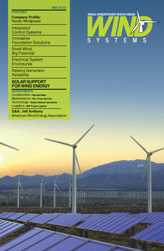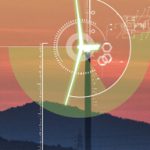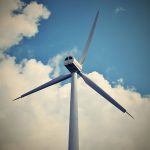As the industry continues to grow and develop and with wind turbines continuing to be deployed across the nation, the likelihood of wind farms being sited near inhabited areas increases. An important constraint on wind turbine placement arises due to the consideration of wind turbine noise. As a key design metric, the noise generated by a turbine can determine its required setback distance from residences or buildings and depends on local community noise regulations. Noise is typically measured on a logarithmic, or decibel scale. As an example, a six decibel increase in the noise of a turbine would double the required turbine setback distance; likewise, a six decibel decrease in noise may allow the turbine to be half as far away. Wind developers seek to place turbines in locations with the optimal wind resource, but as installations encroach populated areas the noise constraint can prevent the optimal placement and adversely impact the economics of a wind farm.
Noise involves several distinct elements, including the source, the propagation through the atmosphere, and the perception, all of which are relevant to wind turbine acoustics and design. It is important to recognize that not all noise is the same, and that not all noise is perceived in the same way. Tones, or noise at discrete frequencies, tend to be perceived as more bothersome to humans than broadband noise, which is spread over a continuous range of frequencies. Low-frequency noise propagates through the atmosphere more efficiently than high-frequency noise, hence it can travel over large distances.
There are two primary sources of noise generated by wind turbines: mechanical noise, and aero-acoustic noise. Mechanical noise involves machinery-generated noise from the gearbox, bearings, and generator. This noise can directly radiate from the machinery components and cause vibration in the surrounding structures such as the nacelle and tower (called “structure-borne” noise).
Mechanical noise often occurs at well-defined tones associated with the rotational frequencies of the machinery components, such as gears and individual gear teeth. Unlike aero-acoustic noise, mechanical noise sources are often easier to isolate since the source and location is well known and can lend themselves to effective mitigation through the use of insulating material in the nacelle and vibration isolation to prevent structure-borne noise.
Aero-acoustic noise is the noise created due to the motion of the rotating turbine blades relative to the surrounding air. Aero-acoustic noise is the result of several complex fluid dynamical phenomena that occur on a wind turbine blade and is usually broadband in nature, meaning that the noise signal is spread over a continuous range of frequencies. A particularly important aero-acoustic noise source is trailing edge noise, which results from the flow of air past the aft, or trailing edge of a blade. For an observer on the ground near a turbine this noise is modulated by the passage of the rotating blades, resulting in a characteristic “swoosh, swoosh” sound. Trailing edge noise imposes a rather strict design constraint on the tip speed of wind turbine rotors, limiting how fast the turbine rotor can rotate.
A key scientific challenge involves the fact that the precise relationship between the shape of a blade design and its aero-acoustic noise signature is not well understood, which makes blade designers apprehensive to large changes that could result in a higher acoustic signature. This constraint tends to limit innovation in blade design.
Key acoustic research being conducted at national labs, universities, and industry is targeted at developing the underpinning technology and analytical tools to better understand the phenomena. Once successful we can expect that not only will wind turbines be able to be sited closer to populated areas, but the overall efficiency of wind systems will increase.


































